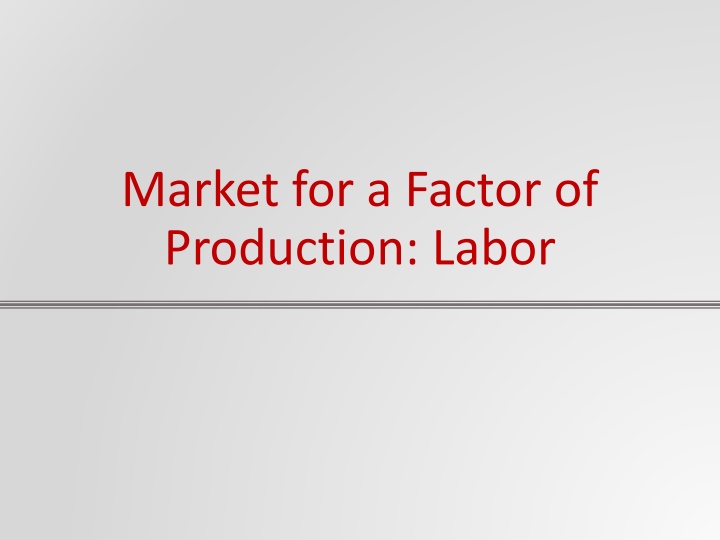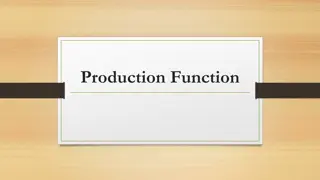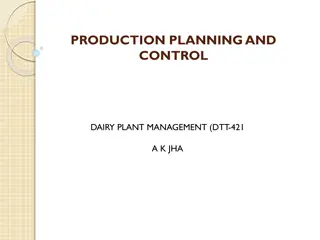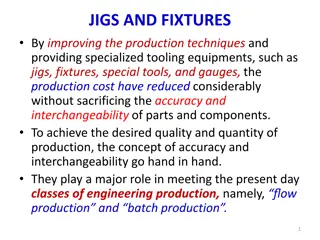
Labor Market Demand and Equilibrium Employment Insights
Explore the concept of derived demand in the labor market, analyzing the marginal product of labor, value of marginal product of labor, and equilibrium employment in competitive labor markets. Learn about factors affecting demand and supply of labor, along with the role of labor unions in wage determination.
Download Presentation

Please find below an Image/Link to download the presentation.
The content on the website is provided AS IS for your information and personal use only. It may not be sold, licensed, or shared on other websites without obtaining consent from the author. If you encounter any issues during the download, it is possible that the publisher has removed the file from their server.
You are allowed to download the files provided on this website for personal or commercial use, subject to the condition that they are used lawfully. All files are the property of their respective owners.
The content on the website is provided AS IS for your information and personal use only. It may not be sold, licensed, or shared on other websites without obtaining consent from the author.
E N D
Presentation Transcript
Market for a Factor of Production: Labor
Acknowledgments This PowerPoint presentation is based on and includes content derived from the following OER resource: Principles of Microeconomics Chapter 4 (Section 4.1 and Chapter 14 (Sections 14.1-14.4) An OpenStax book used for this course may be downloaded for free at: https://openstax.org/details/books/principles- microeconomics-2e 2
Key Questions What do we mean by derived demand? What are the marginal product and marginal revenue product of labor and how do they relate to the demand for labor? What is the marginal cost of labor and how does it relate to the supply of labor? How are employment and wage levels set in a perfectly competitive labor market? How are they determined in an imperfectly competitive market? What do we mean by equilibrium in the labor market and what factors shift the demand and supply curves for labor? What role do labor unions play in wage determination? 3
The Demand for Labor The demand for labor is a derived demand which means that laboris demanded because of the value of the goods or services it produces. That value is the price of those goods and services. In order to find the demand curve for labor, we need to know two things. The marginal product of labor (MPL), which is the change in total output due an additional unit of labor. The price of output (P), which is the market price. The demand curve for labor is the value of the marginal product of labor (VMPL): VMPL = MPL x P 4
The Marginal Product of Labor Assuming that capital is fixed, the marginal product of labor (MPL) falls as more workers are hired. MPL= Total Output / Labor MPL is stated in terms of units of output. 5
The Value of the Marginal Product of Labor For firms selling in a competitive market, the value of additional output sold is the market price, P. The value of the marginal product, VMPL is equal to MPL x P. VMPL, which is stated in dollars, is the demand curve for labor. 6
Equilibrium Employment in a Competitive Labor Market The marginal cost of labor is the cost to the firm of hiring one more worker. In a perfectly competitive labor market, the market wage is the marginal cost of labor. It is also the supply curve for labor. Firms will hire workers up to the point where the going market wage (Wmkt) equals the value of the marginal product of labor VMPL. This is point L1. 7
Demand for Labor in Imperfectly Competitive Output Markets If the firm does not sell in a perfectly competitive market, it faces a downward sloping demand curve for output, which means that in order to sell additional output it must lower its price. In this case, the demand for labor is the marginal product of labor times the firm s marginal revenue. DL = MPL x MR 8
Equilibrium Employment for Firms in Imperfect Markets Firms in imperfect output markets choose the number of workers, L2, where MRPL = Wmkt. Because marginal revenue < price, the demand for labor for a firm competing in an imperfect output market is less than the demand for labor for a firm competing in a perfect competitive market (L1). Consequently, employment will be lower in an imperfectly competitive market. 9
The Market Wage Rate In a competitive labor market, the equilibrium wage and employment level are determined where market demand for labor = market supply of labor. 10
What Determines the Going Market Wage? The market wage rate is determined through the interaction of supply and demand in the labor market. The FRED database has historical data on the minimum wage and median real earnings. https://fred.stlouisfed.org/search?st=wages The Bureau of Labor Statistics database has comparative wage and earnings data for different occupations and populations in the US. https://www.bls.gov/bls/blswage.htm 11
Demand and Supply at Work in Labor Markets The law of demand applied to labor markets: Higher price (wage) in the labor market = a decrease in the quantity of labor demanded by employers. Lower price (wage) = an increase in the quantity of labor demanded. The law of supply applied to labor markets: Higher price for labor = an increase in quantity of labor supplied. Lower price for labor = a decrease in quantity supplied. Equilibrium in the labor market means quantity demanded = quantity supplied. At the equilibrium wage, employers can find workers, and workers can find jobs. 12
Demand and Supply of Nurses (1 of 2) The demand curve (D) shows how many nurses employers will demand at different salary levels. The supply curve (S) shows how many nurses are willing to at different salary levels. The intersection of D and S shows the equilibrium salary and quantity. 13
Demand and Supply of Nurses (2 of 2) At any salary above the equilibrium salary of $70,000, supply exceeds demand and a surplus of nurses exists. Salaries would fall to restore equilibrium. At any salary below the equilibrium, demand exceeds supply and a shortage of nurses exists. Salaries would rise to restore equilibrium. 14
Shifts in the Demand for Labor Factors that can shift the demand curve for labor: Demand for output Education and training Technology The number of companies needing workers Government regulations Price and availability of other inputs 15
Shifts in the Supply of Labor Factors that can shift the supply curve of labor: Size of the labor force (number of people working or looking for work) Skill or educational requirements Government policies 16
Technology and Wages: An Application of Supply and Demand Panel (a): The demand for low-skill labor shifts to the left when technology can do the job previously done by these workers. Panel (b): New technologies can also increase the demand for high-skill labor in fields such as information technology and network administration. 17
Wages and Employment in an Imperfectly Competitive Market There a two sources of imperfect competition in labor markets: Demand side sources - labor market power by employers Supply side sources - labor market power by employees. Monopsony - a sole employer that has no direct competition in hiring, and exploits its market power by offering lower wages than would exist in a competitive market. 18
The Marginal Cost of Labor in a Monopsony Market A monopsony is the sole demander for labor, so it faces the entire market supply curve for labor. In order to increase employment the monopsonist must raise the wage not just for new workers but for all the existing workers they could have hired at the previous lower wage. As a result, the marginal cost of additional hiring labor is greater than the wage, and thus for any level of employment (above the first worker), MCL is above the Market Supply of Labor. 19
Labor Market Outcomes: Monopsony vs. Perfect Competition A monopsonist hires fewer workers, Lm, than would be hired in a competitive labor market, Lc. In exploiting its market power, the monopsonist can pay a lower wage, Wm, than workers would earn in a competitive labor market, Wc. 20
Market Power on the Supply Side of the Labor Market: Unions A labor union is an organization of workers that negotiates with employers over wages, benefits and working conditions. A labor union seeks to change the balance of power between employers and workers by requiring employers to deal with workers collectively, rather than as individuals. Collective bargaining refers to negotiations between unions and a firm or firms using union labor. A labor union operates like a monopolist (a single seller) in a labor market. 21
Union Wage Negotiations Without a union, equilibrium is at E with wage We and quantity of labor Qe. The union is able to use its bargaining power to raise the wage to Wu. At Wu there is an excess supply of labor; that is, the quantity of labor supplied, Qs is greater than the quantity of labor demanded, Qd. 22
Union Membership in the U.S. The National Labor-Management Relations Act specified that workers have a right to organize unions and that management have to give them a fair chance to do so. Government workers comprise several of the biggest unions in the country: American Federation of State, County and Municipal Employees (AFSCME), Service Employees International Union, National Education Association. 23
The Decline in Union Membership in the U.S. The proportion of U.S. workers belonging to unions has declined since the early 1950s. Possible explanations include: The shift from manufacturing to service industries. The force of globalization and increased competition from foreign producers. A reduced desire for unions because of the workplace protection laws now in place. U.S. legal environment that makes it relatively more difficult for unions to organize workers and expand their membership. 24
The Growth in Service Jobs Union membership in the U.S. has declined as service jobs have increased. Outside of government employees, unions have not had great success in organizing the service sector. 25
Bilateral Monopoly A bilateral monopoly is a labor market with a union on the supply side and a single firm (monopsonist) on the demand side. Employment, L*, will be lower in a bilateral monopoly than in a competitive labor market. The equilibrium wage is indeterminate, somewhere in the range between Wu, what the union would choose, and Wm, what the monopsonist would choose. 26






















